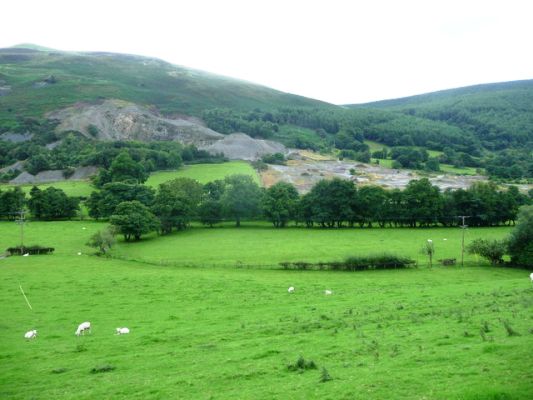
Llangynog Mine
Copyright © Jeremy Bolwell and licensed for reuse under this Creative Commons Licence
This mine is on the southern flank of the Berwyn mountains in Montgomeryshire, on the south side of the valley from Llangynog village. It worked a strong, east to west vein running through shales, mudstones and slates of the Llandeilo or Cardocian stages of the Ordovician period. There is a large circular intrusion of felsite, and the ore is cut off by slate.
The vein runs through three separate estates, Powis, Chirk and Pengwern, but most of the ore came from first. The second Marquess of Powis (1665-1745) was central to the development of Llangynog and saw its richest period. Mining began in earnest around 1705 and ore was shipped to his cupola smelt mill at Pool Quay until around 1755.
The Chirk section, owned by the Myddeltons, was considerably poorer. They worked it jointly with the London Lead Company from 1729. They sank a shaft using a horse whim and by 1731 were in ore, which was taken to a cupola mill being built at Benthall (Ironbridge). By early 1736, however, the company gave up the mine because it had lost some £8,500. This mine was interesting in its having employed a fairly high proportion of English miners, at least some of whom apparently came from Swaledale in Yorkshire.
The Powis section was worked by a series of companies in the nineteenth century. In 1815 the adit cut into the old workings draining them so quickly that the miners barely escaped and the river flooded. Unfortunately, it still did not drain the lowest levels.
By 1838 the Llangynog Lead Mining Company had installed waterwheel driven pumps in the 190 yard deep shaft, but it was soon wound up. It was succeeded by Charles Jones & Co. who drove an inclined plane into the workings for haulage, using a small steam engine.
The Chirk Castle Company was formed to work the Chirk section, but bought Jones out in 1851 and united the principal parts of the mine for the first time. In turn, when the Chirk company failed, its leases were bought, in 1859, by the Llangynog United Company, which was working the Pengwern section. A powerful waterwheel, for pumping, was built and the vein bottoms followed, but it was still cut off by “blue stone” or slate. Nevertheless, the mine get going until 1870, when the New Llangynog company took over. Despite optimistic reports, it had no more success at find good ore and by 1880 the mine was dead.
Williams, R.A. The Old Mines of the Llangynog District (British Mining No.26, 1985)
Return to previous page
